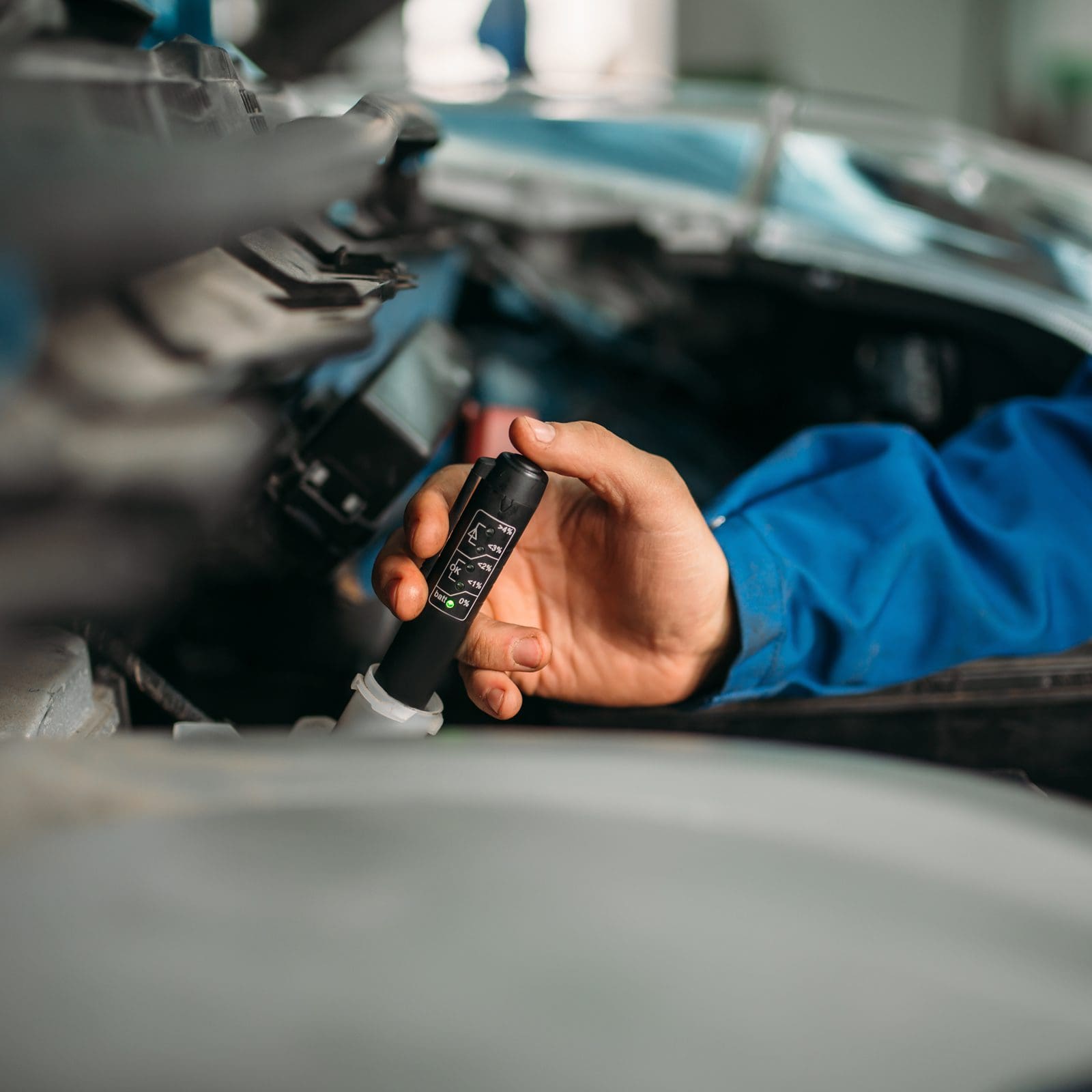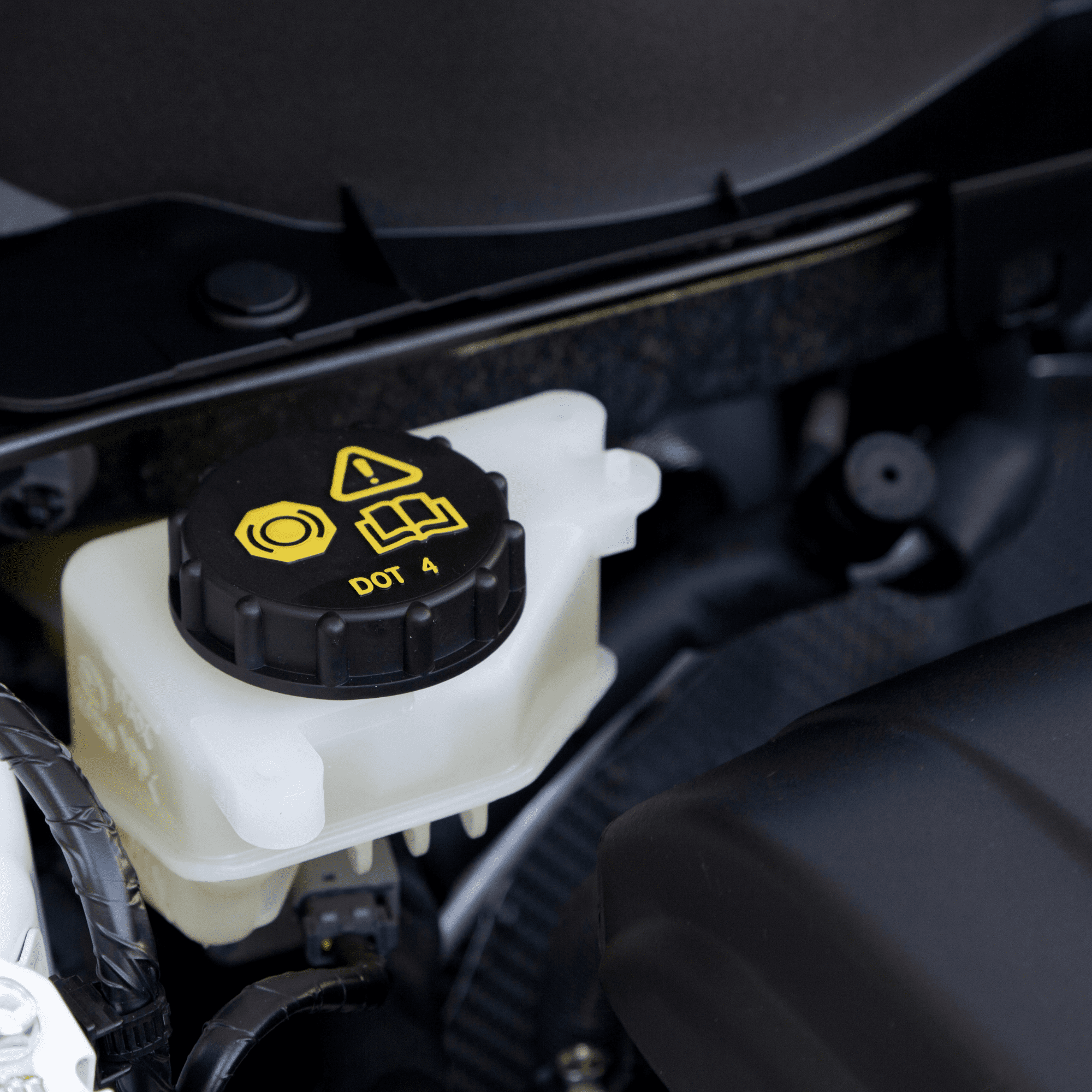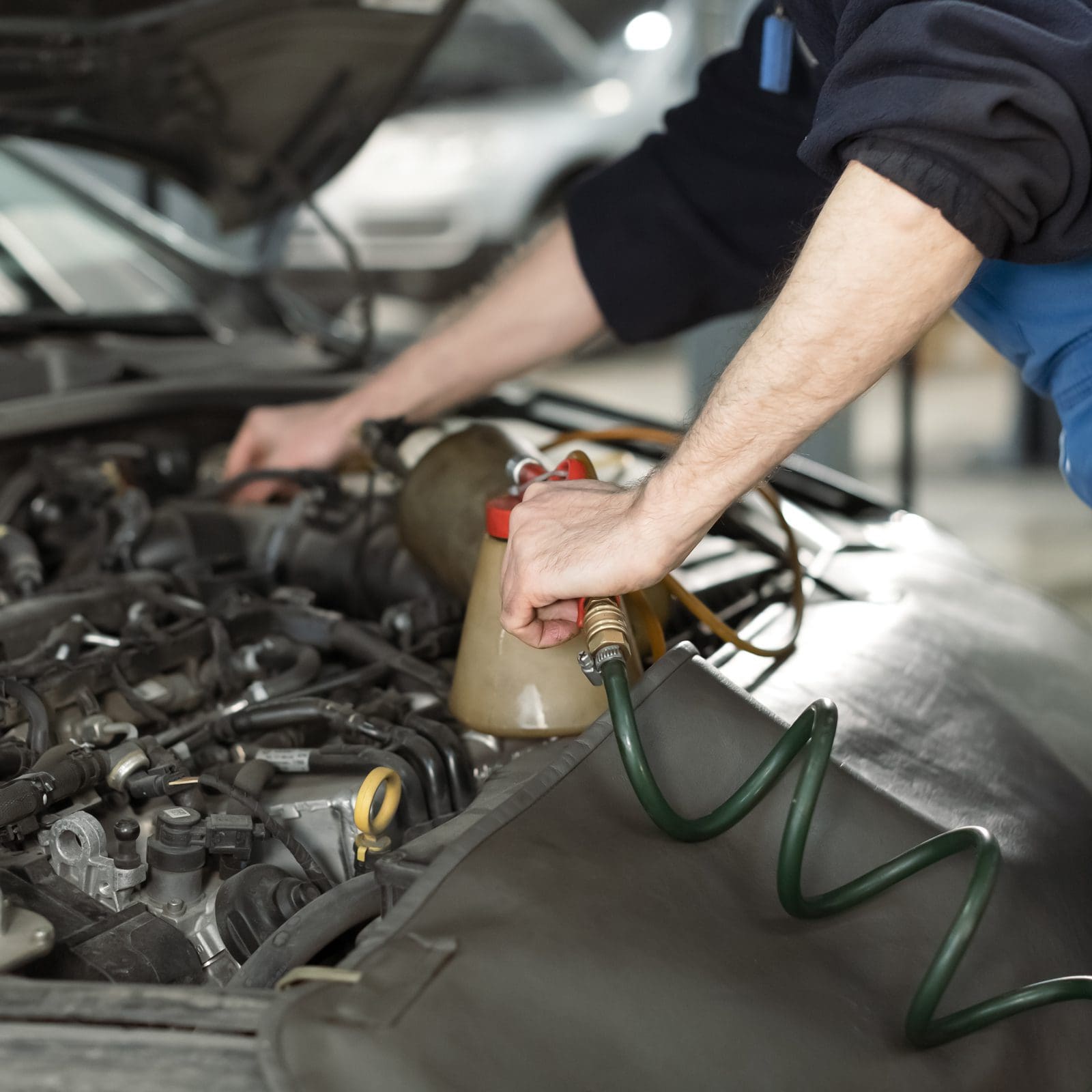OFFERING ALL STANDARDS TESTING AND CUSTOM SOLUTIONS
ABIC Testing Laboratories is a world-class independent testing lab performing brake fluid testing for all major standards, such as FMVSS, AMECA, ISO, SAE, GM, MIL, CMVSS, JIS, etc., and custom solutions.
WHAT IS BRAKE FLUID?
Because of the high-stress, high-friction nature of braking, the brake fluid must operate as intended at high pressures and temperatures.
FMVSS 116 BRAKE FLUID REGULATIONS
FMVSS applies to all vehicles sold and operated in the U.S., including passenger cars, trucks, and buses, as well as their components and equipment. Manufacturers of brake fluid must ensure that their products comply with the requirements of FMVSS 116 and meet the necessary standards for safety and performance.
In addition to federal regulations, some states also may have their own requirements for brake fluid, which may be different from the federal standard. Therefore, manufacturers who want to sell brake fluid in states that have additional testing requirements, must ensure that their products meet both the federal and state requirements.
AMECA BRAKE FLUID CERTIFICATION
SAE BRAKE FLUID STANDARD
In the United States, compliance with the FMVSS 116 is mandatory for all brake fluid sold in the country. SAE J1703, on the other hand, is a voluntary standard and is not a legal requirement. While compliance with SAE J1703 is not mandatory, many brake fluid manufacturers aim to meet the requirements of both FMVSS 116 and SAE J1703 in order to ensure that their products meet the necessary quality and performance standards for safe and effective operation of hydraulic brake systems in the United States.
The SAE J1703 standard specifies minimum requirements for dry and wet boiling points, pH, viscosity, and other properties that affect the performance of brake fluid. It is similar to FMVSS 116, but with some minor differences in the specific tests and procedures used to measure brake fluid properties.
In addition to its requirements for brake fluid properties, SAE J1703 also specifies test procedures for evaluating brake fluid performance in a variety of conditions, such as high-temperature use, low-temperature use, and exposure to water and other contaminants. Most of the test procedures can be found in FMVSS 116.
INTERNATIONAL STANDARDS FOR BRAKE FLUIDS
TO AVOID FAILING THE DOT’S SPECIFICATIONS, WE RECOMMEND REGULARLY TESTING YOUR PRODUCT:
- Test New Product Formulations
- Test Every Reformulation
- Change in Raw Materials Source
- New Packaging and Changes in Packaging
- Periodically to Ensure Continued Compliance
WHAT AFFECTS BRAKE FLUID PERFORMANCE?
Moisture is the primary issue that can inhibit the brake fluid’s performance. Brake fluid is hygroscopic, which means that it absorbs moisture. During storage, transportation, or over shelf life, brake fluid may absorb small amounts of moisture from its surroundings, including the air.
If the water content in brake fluid exceeds 3 percent, it loses its physical properties and may boil inside the brake calipers under hard braking, with the moisture turning to vapor inside the brake lines. This leads to poor braking performance.
Besides water, other matter contamination may also negatively affect brake fluid quality. There are several instances through the production process when a product may get contaminated with dirt and debris. Despite taking precautions and following best practices, any manufacturer may face the issue of contamination during brake fluid production. In fact, product contamination is so common that even large brake fluid manufacturers with internal QC teams hire independent laboratories to test their products to ensure quality control is maintained at the highest level.
Many private brands purchase their product from leading manufacturers. No matter how much you trust the manufacturer, there are multiple instances during production, storage, and transportation when brake fluid may get contaminated – it may pick up moisture or get cross-contaminated. That’s why it is recommended to do routine random testing of products to catch potential contamination or poor quality product.
WHAT MAY LEAD TO PRODUCT CONTAMINATION?
RAW MATERIALS
A change or decrease in quality of raw materials may negatively affect the quality of the final product.
MANUFACTURING
A person’s mistake during manufacturing may negatively affect product quality, which will result in a failed test.
PACKAGING
Contaminated containers or errors in labeling or packaging may lead to failing DOT requirements or product misuse.
STORAGE
In case of poor storage conditions during product’s shelf life, brake fluid may pick up moisture and contaminants, which will result in performance loss.
TRANSIT
Poor handling during transportation and some environmental factors may lead to functional failure.
Tests We Perform
ABIC Testing Laboratories is a world-class independent testing laboratory specializing in brake fluid testing. We offer a wide range of brake fluid testing services, including compliance tests set by the U.S. and international standards organizations, as well as custom and non-standard tests.
Complete Federal Motor Vehicle Safety Standard (FMVSS) 116
DOT 3, DOT 4, DOT 5 or DOT 5.1
Tests included:
- Original Equilibrium Reflux Boiling Point
- Wet Equilibrium Reflux Boiling Point
- Viscosity @-40°F (-40°C) and @212°F (100°C)
- pH
- High Temperature Stability
- Chemical Stability
- Corrosion with 5 % water
- Fluidity and Appearance at Low Temperatures
- Compatibility
- Water Tolerance
- Oxidation
- Rubber Swell (SRB cups)
- Stroke Test
- Color
- Product Label Compliance
Society of Automotive Engineers (SAE) J1703
Tests included:
- Original Equilibrium Reflux Boiling Point
- Wet Equilibrium Reflux Boiling Point
- Viscosity @-40°F (-40°C) and @212°F (100°C)
- pH
- High Temperature Stability
- Chemical Stability
- Corrosion with 5 % water
- Corrosion with no water
- Fluidity and Appearance at Low Temperatures
- Compatibility
- Water Tolerance
- Oxidation
- Rubber Swell (SRB cups)
- Rubber Swell (EPDM rubber)
Society of Automotive Engineers (SAE) J1704
Tests included:
- Original Equilibrium Reflux Boiling Point
- Wet Equilibrium Reflux Boiling Point
- Viscosity @-40°F (-40°C) and @212°F (100°C)
- pH
- High Temperature Stability
- Chemical Stability
- Corrosion with 5 % water
- Corrosion with no water
- Fluidity and Appearance at Low Temperatures
- Compatibility
- Water Tolerance
- Oxidation
- Rubber Swell (SRB cups)
- Rubber Swell (EPDM rubber)
Japanese Industrial Standard (JIS) K 2233 (Class 3, 4, 5, 6)
Tests included:
- Original Equilibrium Reflux Boiling Point
- Wet Equilibrium Reflux Boiling Point
- Viscosity @-40°F (-40°C) and @212°F (100°C)
- pH
- High Temperature Stability
- Chemical Stability
- Corrosion with 5 % water
- Fluidity and Appearance at Low Temperatures
- Compatibility
- Water Tolerance
- Oxidation
- Rubber Swell (SRB cups)
- Rubber Swell (EPDM rubber)
- Stroke Test
International Standards Organization (ISO) 4925 (Class 3, 4, 5-1, 6, 7)
Tests included:
- Original Equilibrium Reflux Boiling Point
- Wet Equilibrium Reflux Boiling Point
- Viscosity @-40°F (-40°C) and @212°F (100°C)
- pH
- High Temperature Stability
- Chemical Stability
- Corrosion with 5 % water
- Fluidity and Appearance at Low Temperatures
- Compatibility
- Water Tolerance
- Oxidation
- Rubber Swell (SRB cups)
- Rubber Swell (EPDM rubber)
Military Specification (MIL) B-46176A
Tests included:
- Original Equilibrium Reflux Boiling Point
- Wet Equilibrium Reflux Boiling Point
- Viscosity @-67°F (-55°C) and @212°F (100°C)
- Viscosity @-67°F (-55°C) and @212°F (100°C): (humidified)
- Flash Point
- High Temperature Stability
- Chemical Stability
- Corrosion (humidified)
- Fluidity and Appearance at Low Temperatures
- Compatibility
- Water Tolerance
- Oxidation
- Rubber Swell (SRB cups)
- Rubber Swell (EPDM rubber)
- Rubber Swell (Natural rubber)
- Stroke Test
Ford Motor Company Standard WSS-M6C65-A1/A2/A3, Draft 12
Tests included:
- Original Equilibrium Reflux Boiling Point
- Wet Equilibrium Reflux Boiling Point
- Wet Equilibrium Reflux Boiling Point ( 3% water added)
- Color
- Viscosity @-40°F (-40°C) and @212°F (100°C)
- % Mineral Oil Content
- % Water Content
- pH
- High Temperature Stability
- Chemical Stability
- Corrosion with 5 % water
- Corrosion without water
- Thermal Stability Corrosion with 5% water
- Thermal Stability Corrosion without water
- Fluidity and Appearance at Low Temperatures (-40C and (-50C)
- Compatibility
- Water Tolerance
- Oxidation
- Rubber Swell (SRB cups & EPDM)
- Stroke Test
General Motors (GM) GMW3356-DOT 4
Tests included:
- Boron Content
- Color
- Flash Point (COC)
- Original Equilibrium Reflux Boiling Point
- Wet Equilibrium Reflux Boiling Point
- % Water Content upon delivery
- pH
- Kinematic Viscosity @-40°F (-40°C), 68°F (20ωC) and @212°F (100°C)
- High Temperature Stability
- Chemical Stability
- Fluidity and Appearance at Low Temperatures (-40°C and (-50°C)
- Water Tolerance
- Oxidation
- Rubber Swell (SRB cups & EPDM)
- Compatibility
- Simulated Service Performance (Stroking Test Properties)
- Reserve Alkalinity (RA)
- Reserve Alkalinity (RA) Retention
- After Oxidation Procedure
- After Volatization Procedure
- Elastomer Compatibility after Aging
- Hydrogen Evolution
- Corrosion with 5 % water plus 25 ppm chloride
- Bench Tests: Preparation of 2 Liters of Aged Brake Fluid plus Stroking Test Properties
- Squeak Testing: Performed by GM only
- Brake Component Testing: Performed by GM only
- Fleet Testing: Performed by GM only
General Motors (GM) GMW16072-DOT 3
Tests included:
- Color
- Flash Point (COC)
- Original Equilibrium Reflux Boiling Point
- Wet Equilibrium Reflux Boiling Point
- pH
- Kinematic Viscosity @-40°F (-40°C), 122°F (50°C) and @212°F (100°C)
- High Temperature Stability
- Chemical Stability
- Fluidity and Appearance at Low Temperatures (-40°C and (-50°C)
- Water Tolerance
- Oxidation
- Rubber Swell (SRB cups & EPDM)
- Compatibility
- Simulated Service Performance (Stroking Test Properties)
- Reserve Alkalinity (RA)
- Reserve Alkalinity (RA) Retentation
- After Oxidation Procedure
- After Volatization Procedure
- Corrosion with 5 % water plus 25 ppm chloride
- Bench Tests: Preparation of 2 Liters of Aged Brake Fluid plus Stroke Test Properties
- Squeak Testing: Performed by GM only
- Brake Component Testing: Performed by GM only
- Fleet Testing: Performed by GM only
Norma Brasileira ABNT NBR 9292
Tests included:
- Original Equilibrium Reflux Boiling Point
- Wet Equilibrium Reflux Boiling Point
- Viscosity @-40°F (-40ωC) and @212°F (100°C)
- pH
- High Temperature Stability
- Chemical Stability
- Corrosion with 5 % water
- Fluidity and Appearance at Low Temperatures
- Compatibility
- Water Tolerance
- Evaporation
- Oxidation
- Rubber Swell (SRB cups)
- Stroke Test
- Color
Canadian Motor Vehicle Safety Standard (CMVSS) 116
Tests included:
- Original Equilibrium Reflux Boiling Point
- Wet Equilibrium Reflux Boiling Point
- Viscosity @-40°F (-40°C) and @212°F (100°C)
- pH
- High Temperature Stability
- Chemical Stability
- Corrosion with 5% water
- Fluidity and Appearance at Low Temperatures
- Compatibility
- Water Tolerance
- Oxidation
- Rubber Swell (SRB cups)
- Stroke Test
- Color
Custom and Non-Standard Tests


